Model: Single-sided PCB
Material: CEM-1/CEM-3/FR-4/Al/PI
Layer: 1Layer
Color: White/Black/Blue/Green
Finished Thickness: 0.6mm-1.6mm
Copper Thickness: 0.5OZ-2OZ
Surface Treatment: OSP
Min Trace: 12mil
Min Space: 12mil
Single sided PCB is to concentrate all parts on one side and all wires on the other side on the most basic PCB Board. Because wires only appear on one side, we call this kind of single sided circuit board. Because there are many strict restrictions on the design circuit of a single panel (because there is only one side, the wiring cannot cross and must go around a separate path), only early circuits used this kind of PCB circuit board.
The wiring diagram of the single sided PCB is mainly screen printing, that is, the resistance agent is printed on the copper surface, the mark is printed with anti-welding resistance after etching, and finally the part guide hole and shape are completed by punching. In addition, some products produced in a small amount and in a variety of ways are patterned by photoresist photography.
The advantages of a single-sided PCB depend on the requirements of the project. Advantages include lower cost, and the single-sided circuit board is the simplest board in each circuit board. Therefore, fewer resources, less time, less design and expertise are required. Because of simplicity, most designers easily design single panels and manufacturers produce them without problems. During batch production, there is basically no problem in the procurement of a 1 layer PCB. Therefore, the delivery time of a single panel is shorter, and the multi-layer panel requires fewer resources.
The disadvantage of a single-sided PCB is its limitations. Not every project is suitable for a single sided PCB. Relatively simple design is one of the biggest benefits of a single panel, but it is also a big one now. For more complex projects requiring more components and links, the single sided printed circuit board reflects insufficient space and efficiency, and the slow operation and speed bring limits. In order to meet customer requirements, the size of single sided PCB needs to be expanded, which leads to the volume and weight of the final product.
Classification of Single sided PCB
94HB single-sided paper circuit substrate, 94V0 single-sided paper circuit substrate, 22F single-sided half fiberglass circuit board, CEM-1 single-sided half fiberglass circuit board, CEM-3 single-sided half fiberglass circuit board, FR-4 single panel fiberglass circuit board, single-sided aluminum circuit substrate, single-sided copper circuit substrate, and single-sided flexible PCB board, etc.
94HB, 94V0, 22F, and CEM1 are the most common single layer PCB materials, and the price is relatively cheap
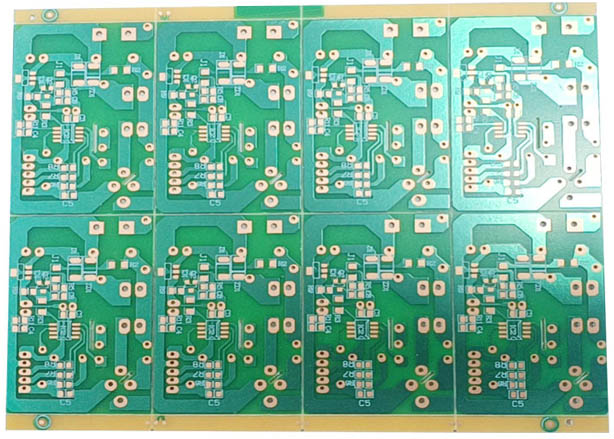
FR1 Single-sided PCB
CEM-3 1 layer PCB and FR4 PCB boards are high-performance and required products, and the price will be expensive compared with several boards.
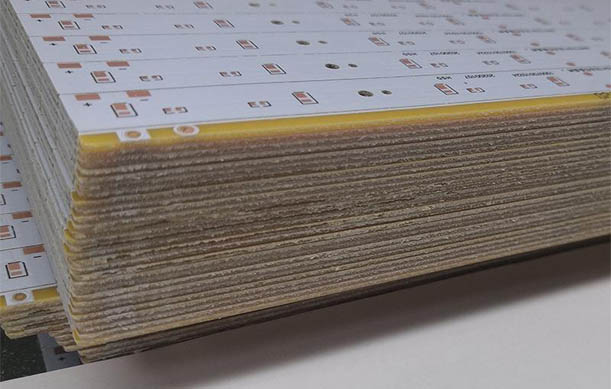
CEM-3 1 layer PCB
Single sided aluminum circuit substrate is commonly used for lighting where LED lamps need rapid heat dissipation. In terms of price, Du Yu's conventional paper substrate and fiberglass board are expensive.
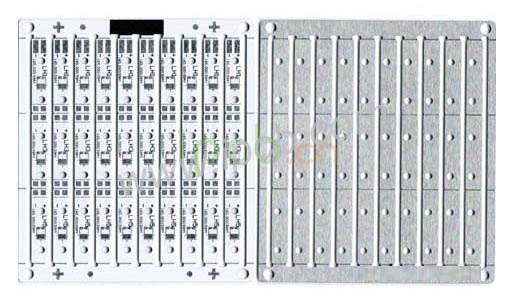
Single sided aluminum circuit substrate
Single sided aluminum PCB is a unique metal based copper clad laminate. PCB aluminum substrate has good thermal conductivity, electrical insulation, and machining performance. The structure is shown in the figure below.
Characteristics of aluminum circuit substrate
1. mounting technology (SMT) for PCB aluminum substrate surface; PCB aluminum substrate has good heat dissipation performance in circuit design scheme;
2. PCB aluminum substrate can reduce temperature, improve product power density and reliability, and prolong product service life;
3. PCB aluminum substrate can reduce the volume and reduce the hardware and assembly cost;
4. PCB aluminum substrate can replace ceramic substrate to obtain better mechanical endurance
Single sided copper PCB substrate is one of the most expensive metal substrates. Its heat conduction effect is many times better than that of the aluminum substrate and iron substrate. It is suitable for high-frequency circuits, areas with large changes in high and low temperatures, and heat dissipation of precision communication equipment and building decoration industries.
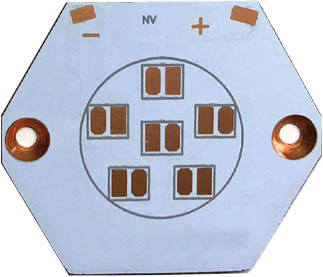
Cu Single sided PCB
The circuit layer of copper substrate requires great current carrying capacity, so thicker copper foil with a thickness of should be used 35μm~280 μm; The thermal conductive insulating layer is the core technology of copper substrate. The core thermal conductive component is composed of aluminum oxide and silicon powder and polymer filled with epoxy resin. It has small thermal resistance (0.15), excellent viscoelastic performance, anti-thermal aging ability and can withstand mechanical and thermal stress. The metal base layer of copper substrate is the supporting component of copper substrate, which requires high thermal conductivity. It is generally copper plate, which is suitable for conventional machining such as drilling, punching, shearing and cutting. The metal layer (block) mainly plays the role of heat dissipation, shielding, coating or grounding. Due to the differences in the performance of copper and aluminum and the corresponding PCB processable process, copper substrate has more performance advantages than aluminum substrate.
Single sided flexible PCB board adopts single-sided PI copper clad board material. After the line is completed, it is covered with a layer of protective film to form a flexible circuit board with only 1 layer conductor. It is used in small and flexible products, which are generally used in portable products. The popularity of portable in the market is so high that the demand for single-sided flexible board increases sharply.
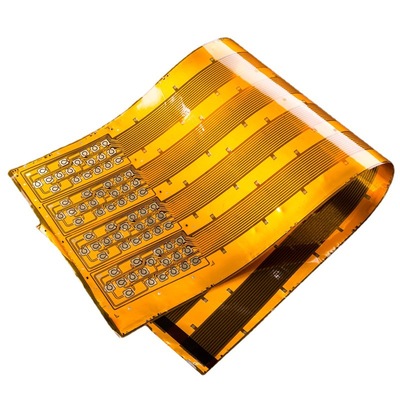
Flex Single-sided PCB
The structure of single-layer PCB is the simplest flexible PCB. Usually, the base material + transparent adhesive + copper foil is a set of purchased raw materials, and the protective film + transparent adhesive is another purchased raw material. Firstly, the copper foil shall be etched to obtain the required circuit, and the protective film shall be drilled to expose the corresponding pad. After cleaning, combine the two with the rolling method. Then, the exposed pad part shall be electroplated with gold or tin for protection. In this way, the big board is ready. Generally, small circuit boards should be stamped into corresponding shapes. There are also those that directly print a solder resist layer on the copper foil without a protective film, so the cost will be lower, but the mechanical strength of the circuit board will become worse. Unless the strength requirement is not high but the price needs to be as low as possible, it is best to apply the method of pasting protective film.
Basic setting of Single-sided PCB design
1. clear structural design requirements.
2. requirements for plate size, size, and position of fixing holes.
3. interface position and PCB height requirements.
4. Other special requirements, such as size and position requirements of the heat sink.
Single Circuit board wiring
1. Avoid sudden change of line width and impedance.
2. Avoid acute angles and right angles, and adopt 4.5° Routing.
3. The signal shall be as short as possible.
4. The signal lines of adjacent layers are in an orthogonal direction to avoid cross-interference.
5. All kinds of signal routing cannot form a loop.
6. Input and output signals shall avoid adjacent parallel lines and mutual coupling as far as possible.
7. The direction of the power line and ground wire of the double-sided PCB board should be consistent with the data flow direction to enhance the anti-noise ability.
8. The connection status shall be carefully considered for digital and analog. Multi-point series grounding shall be adopted for the high-frequency PCB. For digital circuits, The line shall be closed to form a loop to improve the anti-noise ability.
9. For high-frequency signal lines, the line width shall be considered according to their characteristic impedance to achieve impedance matching.
10. The wiring and drilling of the whole PCB shall be uniform to avoid obvious uneven density.
Single sided PCB process flow
Single sided copper clad laminate - > blanking - > (brushing and drying) - > drilling or punching - > screen printing circuit anti etching graphics or using dry film - > curing inspection and repair board - > etching copper - > removing anti-corrosion printing materials and drying - > brushing and drying - > screen printing solder resist graphics (commonly used green oil), UV curing - > screen printing character marking graphics, UV curing - > preheating Punching and appearance - > electrical opening and short circuit test - > brushing and drying - > precoating anti oxidant for welding aid (drying) or tin spraying hot air leveling - > inspection and packaging - > finished products leave the factory.
iPCB supplies cheap single side PCB. If you need single side PCB board, please contact us.
Model: Single-sided PCB
Material: CEM-1/CEM-3/FR-4/Al/PI
Layer: 1Layer
Color: White/Black/Blue/Green
Finished Thickness: 0.6mm-1.6mm
Copper Thickness: 0.5OZ-2OZ
Surface Treatment: OSP
Min Trace: 12mil
Min Space: 12mil
For PCB technical problems, iPCB knowledgeable support team is here to help you with every step. You can also request PCB quotation here. Please contact E-mail sales@ipcb.com
We will respond very quickly.